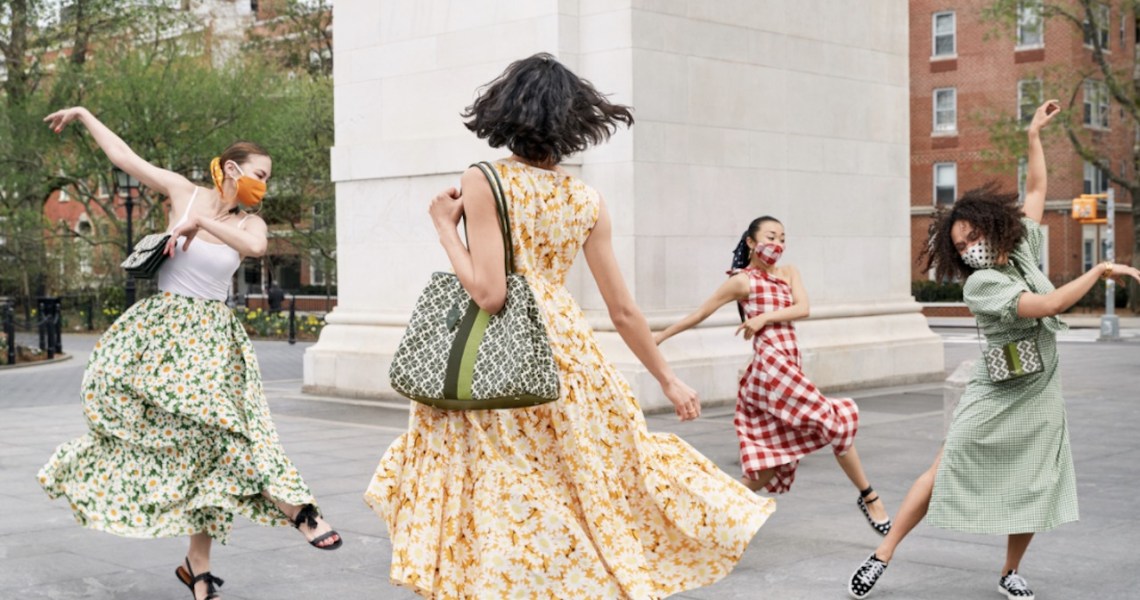Kate Spade is taking very different approaches to Instagram and TikTok.
On the former, Kate Spade has amassed nearly 3 million followers, and features beautifully produced photography showcasing products, campaign imagery and brand announcements. On TikTok, the brand has only posted four videos and has less than 3,000 followers. But it’s TikTok that has the brand excited right now, according to CMO Jenny Campbell.
The brand released its summer campaign on Tuesday via ads on Instagram, Facebook, Pinterest and connected TV apps like Hulu. But TikTok is an exciting new channel for the brand. Campbell said the brand has seen “an incredible surge in organic performance” on TikTok. In the first 24 hours after the campaign launched on TikTok, the accompanying hashtag #KateSpadeNYHappyDance was viewed more than 950 million times.
The brand’s presence on TikTok is largely made up of organic posts from fans, as well as posts created by paid influencers like Todrick Hall (1.1 million followers) and Kelli Erdmann (1.9 million followers). The brand’s making a bigger impact on TikTok when it comes to organic user-generated content, compared to Instagram, as there are more posts featuring the brand. The #KateSpade hashtag has been posted on TikTok nearly 100 million times and less than 6 million times on Instagram. Its Instagram account launched in February 2011, while its TikTok account only launched last month.
“We know that each social platform has a different audience who does not necessarily want to see the same [brand] content [across] channels, and our social strategy reflects this mindset,” Campbell said. “We know that on Instagram our followers love to see beautiful product imagery and storytelling, while our audiences on YouTube are looking for longer-form video content as a form of entertainment. On TikTok, the content needs to be entertaining. Users will see more content from creators that they engage with than [from] those they simply follow but scroll past.”
The Kate Spade campaign makes ample use of the user-driven nature of TikTok marketing. While the main Kate Spade account shared a video of a dance created by choreographer Dylan Pearce and singer Ines Nassara, Campbell expects the bulk of engagement to come from influencer-created takes on the routine, like ones posted on Tuesday by popular TikTok dancers Hall and Erdmann. The campaign is also accompanied by a paid TikTok hashtag challenge, which has been a popular strategy among brands like E.l.f.
On Instagram, brands typically see more engagement by posting highly produced content, while on TikTok, behind-the-scenes videos, informal interviews and casual conversations are far more popular. In a prior interview, Amanda Bopp, vp of digital marketing and CRM at Kate Spade, told Glossy that the brand invites TikTok influencers to shoot videos at brand campaign shoots, saying it’s an effective way to get authentic content out into the world that also references upcoming campaigns and collections.
Ad position: web_incontent_pos1
While an influencer-led TikTok strategy is common, the higher end a brand is, the more produced its TikTok content tends to be. Dior, for one, regularly posts snippets of campaign videos that are made in-house and feature models instead of influencers. Those videos regularly get more than 4 million views.
“On TikTok, the things that work best are more authentic and less aspirational, compared to what you might see on other platforms,” said Cece Vu, head of fashion and beauty partnerships at TikTok. “They don’t need to be highly produced, they just need to be entertaining or educational.”
Quarter earnings for the period ending in March for Kate Spade parent company Tapestry showed that Kate Spade has seen a lot of organic growth online. More than 300,000 new customers and 150,000 lapsed customers were added that quarter, driven through social media, particularly TikTok. Digital sales for all of Tapestry’s brands were up by 30%.
“With the ever-changing cultural and social landscape, we are adapting to a more consumer-centric model on all of our channels,” Campbell said. “TikTok, however, allows us to connect with audiences in a way that gets them directly involved in the fun, while also encouraging them to create content through their own unique perspectives.”




